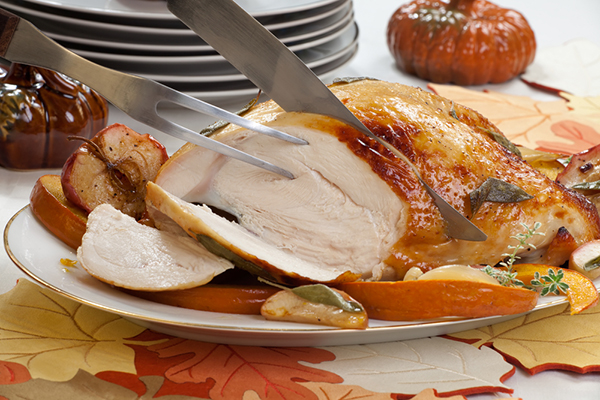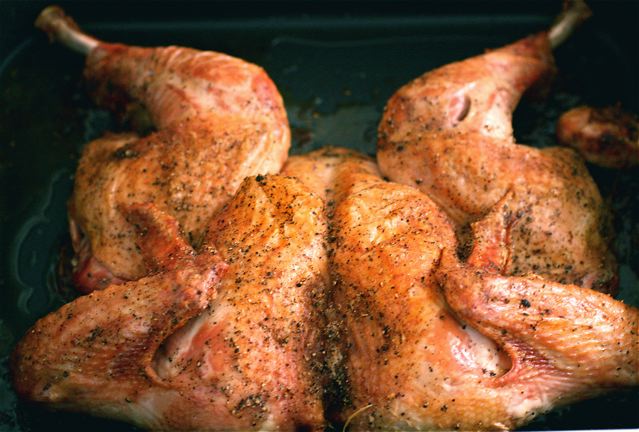The Procrastinator's Guide To Cooking Thanksgiving Turkey
Food Republic's column Ask Your Butcher seeks to answer FAQs in the world of butchery. Ethically minded butcher Bryan Mayer has opened butcher shops and restaurants, and has trained butchers in the U.S. and abroad. He helped develop the renowned butcher-training program at Fleisher's. Today, he consults with farmers, butchers, chefs and anyone else who will listen. In each column, Mayer tackles a pressing issue facing both meat buyers and home cooks. This week, Mayer has some advice for those of you procrastinating about Thanksgiving cooking: Don't panic!
This week's column isn't for the planners out there. You folks are covered. You started asking your butchers sometime right after Labor Day when you could order your turkey, what sizes would be available and whether there would be any sides, giblets, gravy or stuffing offered. No, this isn't for you. This is for the dawdlers out there, watching countless replays of the new Force Awakens trailer instead of planning for the most food-focused holiday we have. Of course, Thanksgiving is more than that, or at least should be. But no other holiday drives people to fits of insanity quite like Thanksgiving. I've seen grown men break down in tears when they find out their 18-pound turkey is 18 and a half pounds and now won't work for their brown-bag turkey. Note: Please don't ever do this — brown paper bags were never intended as cooking utensils. I've seen arguments over what the appropriate size turkey is for five people. Note: It is most definitely not 25 pounds! And I've seen bidding wars break out over the last turkey in house.
With the alternative being buying a lesser turkey — maybe even a Butterball (gasp) — things start to look pretty bleak a few days before the holiday, especially if you're looking for the great flavor of a pasture-raised turkey. And I know you are. While I could try to convince you that turkey was most certainly not the centerpiece of the first Thanksgiving and maybe doesn't need to be yours, either, we all know you're not going to cook venison, goose, duck, lobster or any other more traditional meats. I'm here to tell you that things are going to be okay. We butchers are quite experienced at remedying such calamities. Trust us, have a bit of an open mind and accept the fact that there might not be a whole turkey on your table. Remember, this is your fault. But we'll fix it!
Turkey Breast
It's no secret that we are a white-meat-loving society. Whether it's the color of the dark leg meat (which means it's flavorful), the supposed toughness or the fact that it looks like, well, a leg, who knows? Most butchers I know will break down whole birds for customers looking to celebrate the holiday in a more controlled fashion. Their restraint is your victory. And around this time, there always seem to be a few odd breasts around. The preparation for a turkey breast is quite simple: Season and bake. We're looking for an internal temp of 150°F, which should take a little more than an hour in a 425°F oven. With the reduced cooking time, you'll have more than enough left over to prepare the "traditional" sides and keep the libations flowing. You'll want to keep those traditionalists happy.
Let's start with a simple herbed butter recipe that should keep you stocked for a bit. You definitely don't need the whole stick for one meal!
Ingredients
1/2 cup grass-fed unsalted butter, softened to room temperature
1/4 cup finely chopped mixed herbs (basil, thyme, sage, parsley, dill, chives, tarragon, oregano, marjoram or rosemary — whatever you've got handy or want)
1 teaspoon coarse sea salt
1 teaspoon freshly ground black pepper
Directions:
For the turkey:Ingredients
1 (preferably bone-in, skin on) or more 5-pound, fully pastured turkey breast
Salt and pepper
Directions:
Turkey Breast Porchetta
Okay, so maybe showing up to the table with a plain old turkey breast is highlighting the fact that you messed things up. Well, turkey breast porchetta is the best intentional mistake you had no idea you know you made. Or is it the best unintentional mistake you know you made? Whichever it may be, it's awesome. It requires a bit of knife skill, as the breast will need to be butterflied, but your butcher will be more than happy to help with that. And it requires a bit of trussing skill, which we've covered here before. That's it. Brine with your choice of seasonings, give it a quick sear and bake away. I like to dry-brine my turkey porchetta much in the same way I would dry-brine something like pork belly. It helps to break down some of the muscle proteins and retain water while adding flavor, which is perfect for a quick overnight cure.
Hot tip: For even crispier skin, add a little baking powder. Like the chicken breast above, you're looking for an internal temp of about 150°F. This will take a bit longer to cook, but at roughly two hours in a 275°-300°F oven, we're well below whole-turkey times here.Ingredients
1 or more (bone out, skin on) fully pastured full turkey breast.
1 tablespoon olive oil
¼ cup rosemary
¼ cup thyme
¼ cup sage
½ cup anise
3 cloves of garlic
Salt and pepper
Baking powder
Directions:
Braised Turkey Legs
So far, this column has been a bit one-sided in favor of white meat. I've seen way too many turkey legs (along with their winged companions) relegated to the stockpot in the back of the kitchen, never fully realizing their potential as a Thanksgiving centerpiece — let's change that. Braising makes so much sense for a holiday like Thanksgiving. I defy anyone to withstand the tempting smells of slow-cooked meats, bubbling away, slowly, in wines and sauces! Besides, not to get your hopes up about the last two recipes, but you'll probably have an easier time finding legs, and you're going to need to braise them. It's foolproof. A little more prep time is involved here, but it's nothing you can't handle at this point. Sear both sides, cook your veggies and reduce your wine, add back your legs with some turkey stock, and braise away! All that residual liquid left over after you're done cooking becomes a rich, velvety sauce with just a bit of butter and flour.
Ingredients
At least 2 whole (thigh and leg) turkey legs, skin on
Your standard mirepoix of 1 medium onion, 1 large carrot and 1 large celery stalk, all roughly chopped
3 sprigs of fresh thyme
3 sprigs of fresh rosemary
2 cups of (preferably dry) red wine
1 quart turkey or chicken stock
Salt and pepper
Keep in mind that this recipe is easily doubled or tripled. Just get yourself a larger, deep cooking vessel.Directions:
Whole Turkey (Spatchcocked)
There is the slightest of chances that you might be able to score a whole turkey. That turkey will most probably be huge. Like, ridiculously huge. No worries, as we'll cover what to do with all those leftovers soon enough. While you may think you've struck gold by scoring a whole bird, I want you to listen very closely: Don't even think about cooking it any other way than spatchcocked. We've covered all the reasons why spatchcocking is the way to go: Increased contact with the cooking surface results in a much more even and faster cooking time, crispier skin and juicier meat. Do you need any more reasons? Removing the backbone is a simple task for you or your butcher, and that's about all the prep you'll need, short of seasoning and preheating your oven. 450°F for 2 to 2½ hours, or until your breast reads 150°F and your leg is at 165°F. You can dry-brine this if you'd like, but it's not necessary. A bonus here is that you'll have not just the neck, but also the back for making gravy.
Ingredients
1 whole, fully pastured bird (it'll probably be a big one)
Salt and pepper
Baking soda
Directions:
You've saved Thanksgiving! Now let's try and be a bit more proactive for the rest of the holiday season, what do you say?




